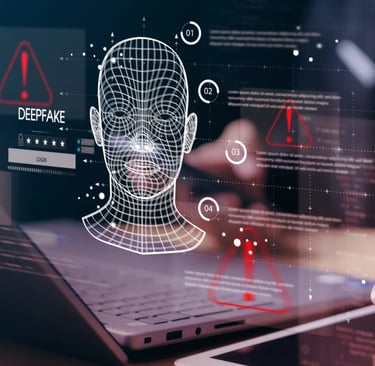AI-Powered Cyber Threats: How Attackers Use Automation and Deepfakes in 2025
10/18/20251 min read


AI is accelerating cyberattacks — from automated phishing to deepfakes. Learn how defenders must adapt in 2025.
Introduction
Artificial intelligence is reshaping cyber offense and defense simultaneously. While AI provides defenders better detection and automation, adversaries are using AI to generate hyper-personalized phishing, deepfake audio and video, and automated exploitation at scale — forcing new controls and governance models.
Why this trend matters (data-driven insights)
Microsoft and other telemetry show a sharp rise in AI-enabled campaigns — including hundreds of AI-generated disinformation and impersonation incidents recorded in recent months — signaling state and criminal adoption of AI tooling. AP News
IBM highlights “shadow AI” (unsanctioned AI usage within organizations) as a major data-security and governance risk for 2025, increasing the possibility of data exposure and misuse of models. IBM
Trend explanation
Attackers use generative models to craft believable spear-phishing messages, synthesize voices for vishing (voice phishing), and generate tailored social-engineering scripts — allowing scale and effectiveness beyond manual phishing. AP News
Shadow AI inside enterprises creates attack surfaces: sensitive data used to fine-tune internal models can leak or be abused. IBM recommends identity-first controls and data governance. IBM
Real-world examples / case studies
State-actor impersonations & disinformation: Microsoft’s telemetry observed dozens of incidents of AI-generated impersonations and fake content used in targeted campaigns. AP News
Rise of AI-enabled vishing and voice scams: Vendors and threat reports have recorded surges in voice phishing enabled by synthetic audio (see vendor threat bulletins). CrowdStrike
Best practices & expert recommendations
Adopt identity-first controls (strong MFA, adaptive access) and least privilege for model and data access. IBM
Detect and govern shadow AI: maintain inventory of internal AI tools, enforce data handling policies and logging for model training datasets. IBM
Invest in behavioral detection & anomaly analytics — look beyond signatures to detect AI-driven social engineering and abnormal flows. CrowdStrike
Train staff on AI-sophisticated phishing: realistic tabletop exercises that include deepfake scenarios.
Conclusion & future outlook
AI will continue to amplify both offense and defense. Organizations that combine strong identity controls, AI governance, and behavior-centric detection will mitigate the worst impacts. Expect regulators and industry to push model-data governance standards in the next 12–24 months. AP News
